Synthetic Cultivars
Walter R. Fehr and Walter P. Suza
Readings:
- Chapter 33 [PDF], Principles of Cultivar Development. Vol. 1: Theory and Technique, by Walter R. Fehr (Access the full book)
In the United States, the primary use of synthetic cultivars is for forage and turfgrass species. In other parts of the world, synthetic cultivars, sometimes referred to as open-pollinated cultivars, are used for additional crops such as maize. The focus of this chapter will be on forage and turfgrass species.
Forage and turfgrass species have some common characteristics that are important for breeding synthetic cultivars.
- Although they have perfect flowers, self-pollination is minimized because of self-incompatibility.
- Synthetic cultivars are highly heterozygous and heterogeneous. Inbreeding depression is severe and plants that develop from self-pollinated seed lack the vigor of those obtained by cross-pollination.
- In a heterogeneous population, each plant is genetically different from another. Although it is appropriate to refer to each individual plant as a genotype, it is common to refer to each plant as a clone because it is possible to propagate individual plants vegetatively.
- The species are perennials.
There are four steps in the development of a synthetic cultivar.
Step 1: Develop a segregating population for selection
There are two common types of populations used for selection.
- (1) Synthetic cultivars per se can be used as populations because they are heterozygous and heterogeneous. One example was the use of the synthetic cultivar Freedom red clover as the population for selection of the cultivar Freedom MR! [JPR 2:205–207 (2008)].
Populations are formed by intermating clones from different sources. The intermating is commonly done by planting the clones in a polycross and allowing them to cross naturally by wind or insects. The parent clones are selected based on the traits that the breeder would like to have in a new cultivar. The parent clones commonly differ in the traits that they contribute to the population, which makes it possible to select for multiple traits among the progeny. For example, the synthetic cultivar Recovery wheatgrass [JPR 5: 367–373 (2011)] was derived from three parent clones, Rosana, D2945, and WW117FC that differed in vigor, seedling establishment, sod-forming ability, and forage and seed production.
Step 2: Selection of superior clones
Selection begins as soon as seed of the segregating population is available. There is no inbreeding of a population because of severe inbreeding depression.
The first evaluation of individual clones generally is done by phenotypic selection. A breeder may evaluate thousands of plants for traits of importance. If selection is practiced for disease or insect resistance, artificial infection commonly is done in a controlled space, such as a greenhouse or growth chamber. The breeder may select in a stepwise manner to improve the efficiency of the process. For example, selection may be practiced for resistance to one disease, following which the selected individuals are exposed to a second disease. After the second selection, the chosen clones may be vegetatively propagated to the field where they are evaluated for response to environmental factors, such as winter hardiness and plant vigor.
It is common for breeders to use recurrent phenotypic selection for one or more cycles to improve the population for traits of interest. The improved population per se may become a new synthetic cultivar. For example, the synthetic cultivar TifQuik bahiagrass [JPR 5:147–150 (2011)] was a result of four cycles of selection for fast germination from the cultivar Tifton.
If genotypic selection is used to identify superior clones, it generally is done after phenotypic selection has been used to select clones for traits of interest in a new cultivar. Genotypic selection is done to determine the general combining ability of clones for traits that are considered difficult to assess on a phenotypic basis, such as yield. The clones to be evaluated are grown in a polycross to obtain half-sib seed. The half-sib seed is harvested from each clone and planted in replicated tests in multiple environments. A test at a location generally is evaluated for multiple years under the conditions in which the species is grown commercially. For example, the cultivar Nelson annual ryegrass [JPR 5:45–48 (2011)] was developed for use as a forage crop in the southern USA and field tests for performance were evaluated at Overton and Beaumont, Texas, across 3 years.
When genotypic selection is practiced, the clones under evaluation generally are maintained in the field, commonly referred to as a maintenance nursery. After the superior clones are selected, vegetative propagules from the maintenance nursery are used for production of seed for testing experimental synthetics and seed of the final cultivar.
An example of the process of developing a synthetic cultivar is provided for alfalfa in the following presentation by Sheilah Oltmans-Deardoff:
Here is another presentation on alfalfa breeding. Photographs were provided by Robert Clark, Forage Genetics International at Boone, IA, and Charles Brummer, The Noble Foundation at Admore, OK:
Descriptions of the steps presented in the slides are presented below:
- Seed of an existing cultivar or the hybrid seed obtained by crossing selected individuals is germinated in a greenhouse or growth room to obtain thousands of seedlings, each of which is genetically different. The seedlings (clones) may be evaluated for traits of economic importance in a greenhouse, such as disease resistance, to identify those to be transplanted to the field for further evaluation.
- The seedlings are space planted in the field.
- Seedlings can be manually transplanted in the field.
- The individual clones commonly are evaluated for multiple years to select for ability to survive during the winter (winter hardiness), spring regrowth, forage yield, and resistance to insects and diseases.
- Some of the clones do not survive under field conditions. Those that exhibit superior phenotypic traits are selected. Cuttings are taken from the selected clones for use as parents for crossing, such as in a program of recurrent phenotypic selection, or they may be mated in a polycross for genotypic evaluation with half-sib families.
- Pieces of the stem of selected clones are harvested in the field, wrapped in a wet towel, and placed in a cooler with ice. The cuttings may be used for manual crossing in a greenhouse or sent to Idaho for planting in a cage where bees are used for crossing.
- A piece of stem with one node is planted in a rooting media to obtain a seedling.
- These persons are preparing stem cuttings taken from the field and placing them in the rooting media.
- After the cuttings have developed roots, they are transplanted to pots in the greenhouse for manual crossing or to cages in Idaho for crossing with bees.
- These persons are making a polycross of the clones in pots around the room. Pollen is manually transferred among the clones. Note that the persons are sitting on stools so it is easy to move from one plant to another.
- For conducting a manual polycross, pollen is transferred among the parent clones by tripping their flowers with a folded piece of paper. Note the pollen on the tip of the paper. The pollen of different plants is mixed together as the flowers are tripped; and as a flower is tripped, the mixed pollen sticks to the stigma, which leads to fertilization.
- The pollinated flowers are identified with a tag. The person is holding a mature pod that contains hybrid seed. Each of the seeds in a pod will be genetically different because the pollen is heterogeneous. The seed from each plant is harvested separately. The seed from the parent clones can be mixed together to form a segregating population for further selection or it can be kept separate for evaluating the parent clone genotypically as a half-sib family.
- The alternative to manual crossing is to plant the parent clones in a cage where bees are used for crossing. The polycross may be used to produce Syn.1 seed of an experimental synthetic. There can be as many as 200 different experimental synthetics evaluated in a year.
- The experimental synthetics generally are evaluated with Syn.1 or Syn. 2 seed in multiple locations during several years.
- The field trials are sown with a self-propelled planter.
- Powered equipment may be used for planting field trials. Photo courtesy of Charles Brummer, The Noble Foundation.
- A typical design for alfalfa yield trial.
- The half-sib families or experimental synthetics are evaluated visually for disease and insect resistance, winter hardiness, regrowth after cutting, and other important traits.
- Forage yield is evaluated with a self-propelled harvester. Samples of the forage are taken to the laboratory to evaluate traits such as digestibility.
- Alfalfa seed production in Idaho. Structures in the middle of the field are leafcutter beehives. Leafcutter bees are used for pollination.
Here is another presentation on alfalfa breeding. Photographs were provided by Robert Clark, Forage Genetics International at Boone, IA, and Charles Brummer, The Noble Foundation at Admore, OK:
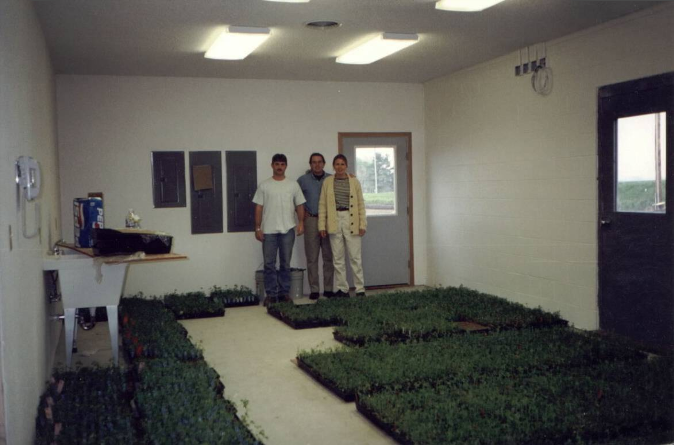
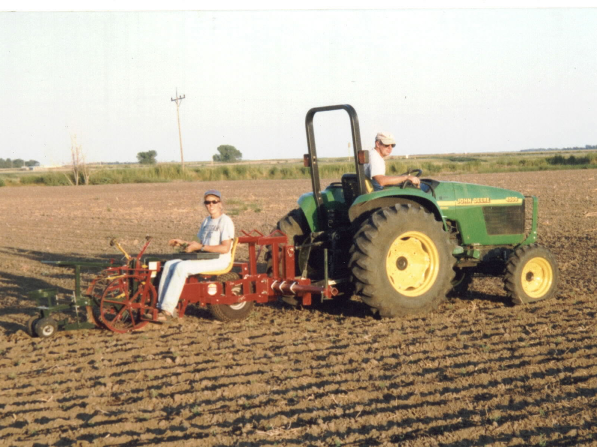
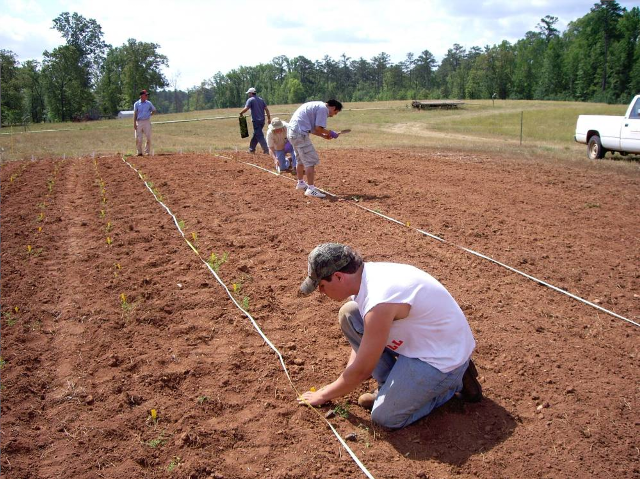
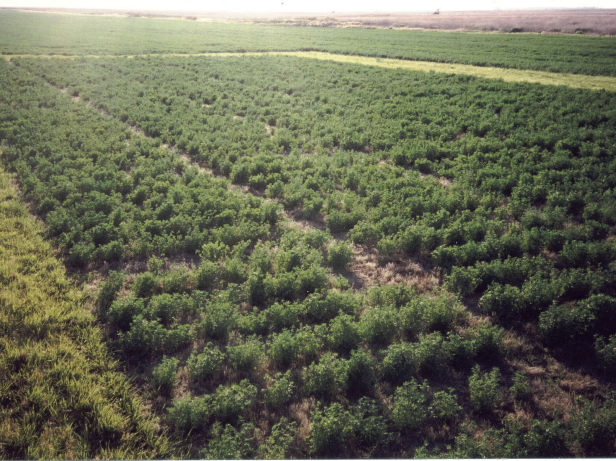
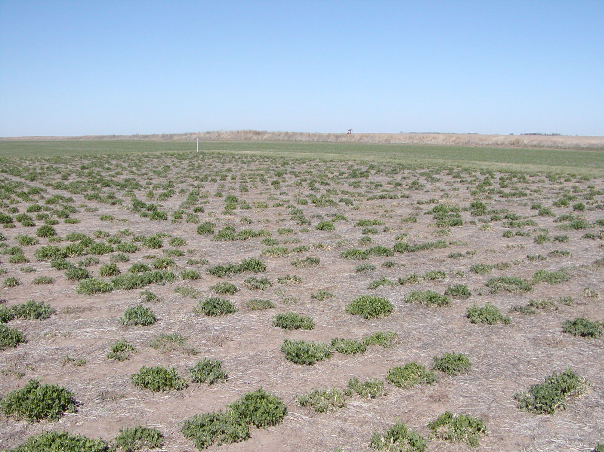
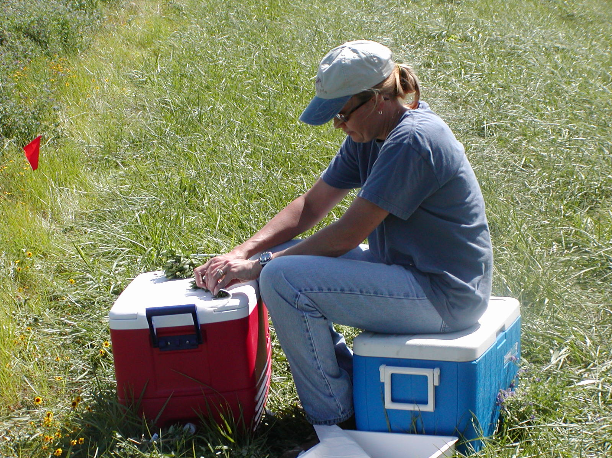
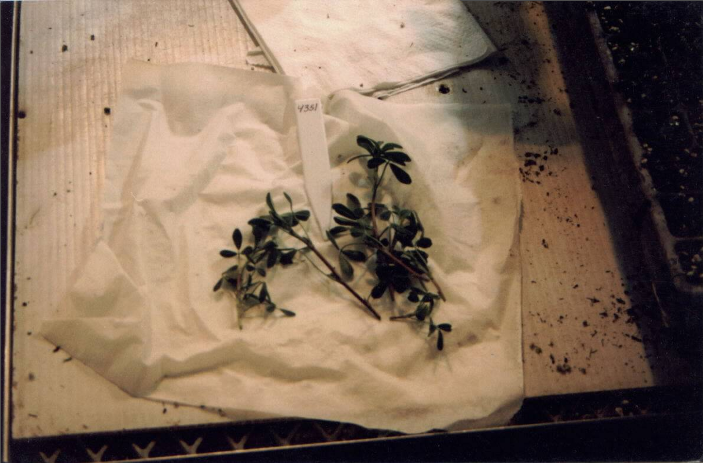
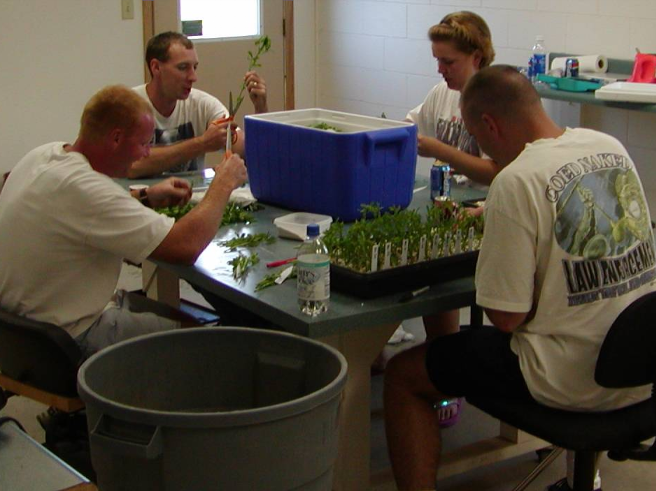
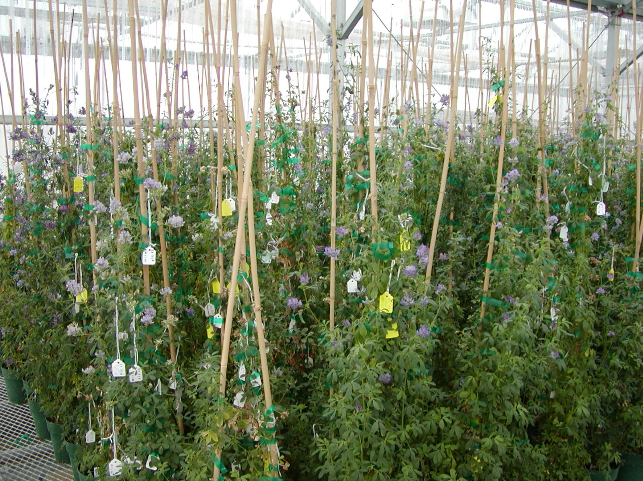
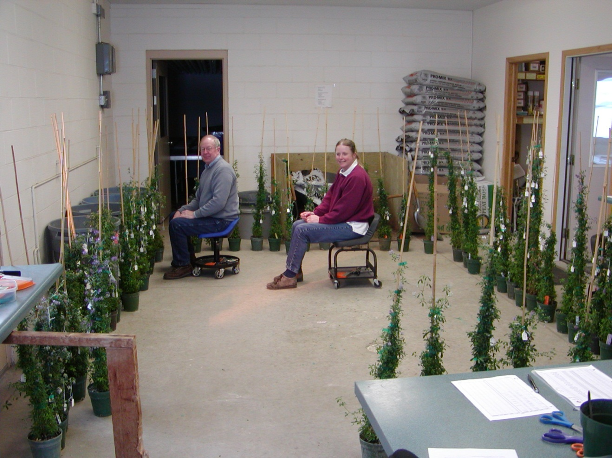
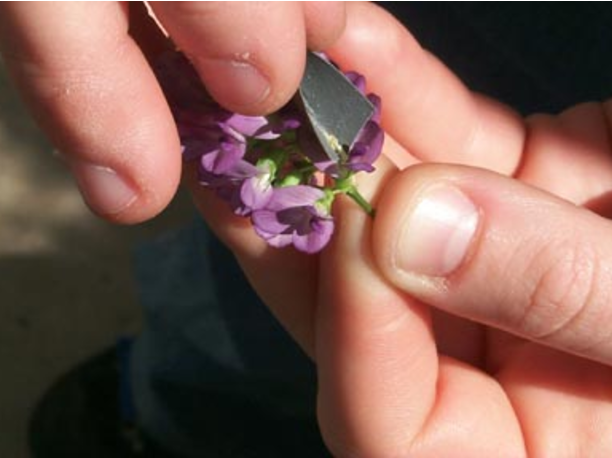
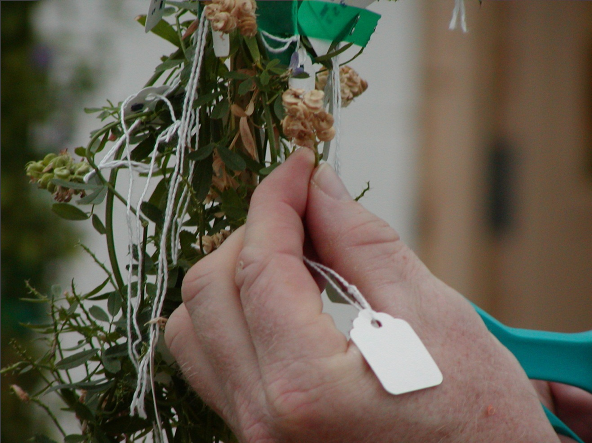
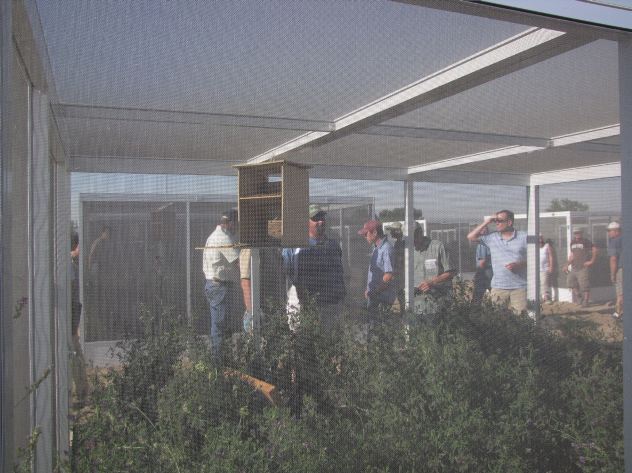
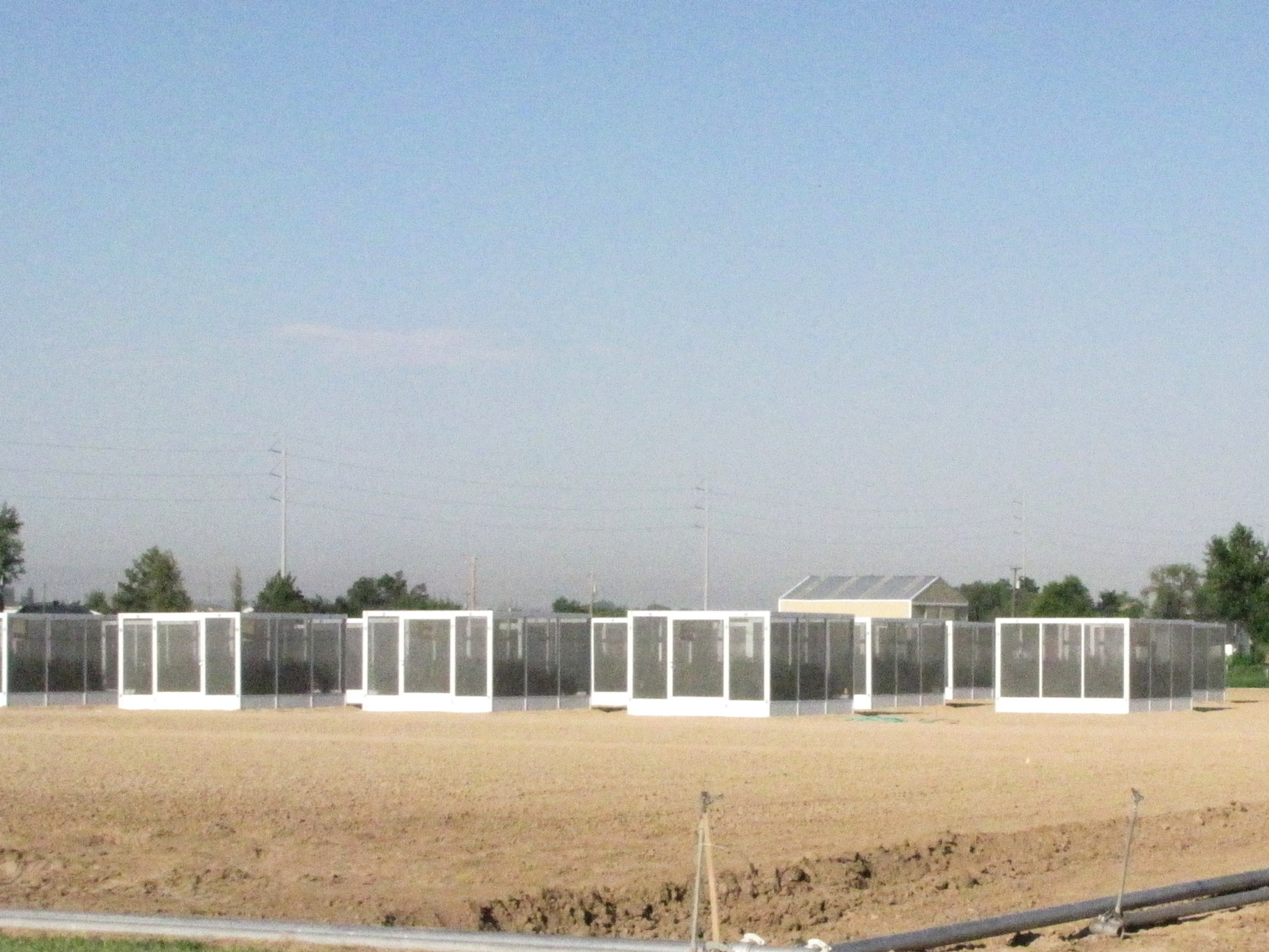
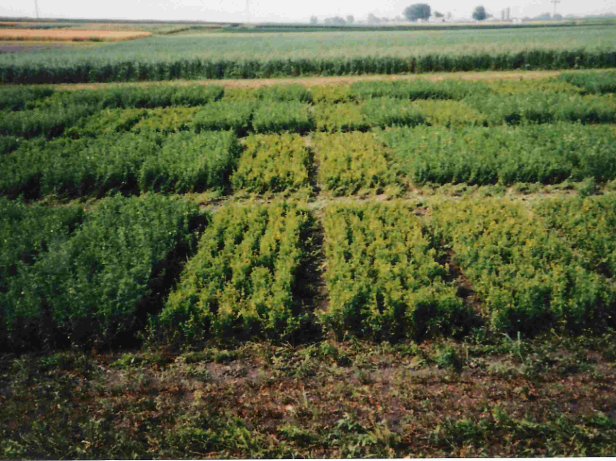
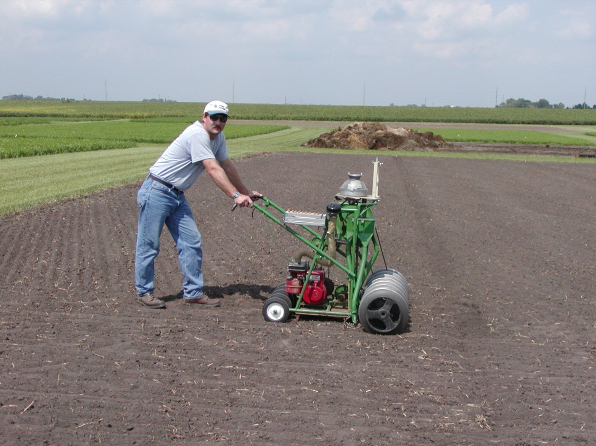
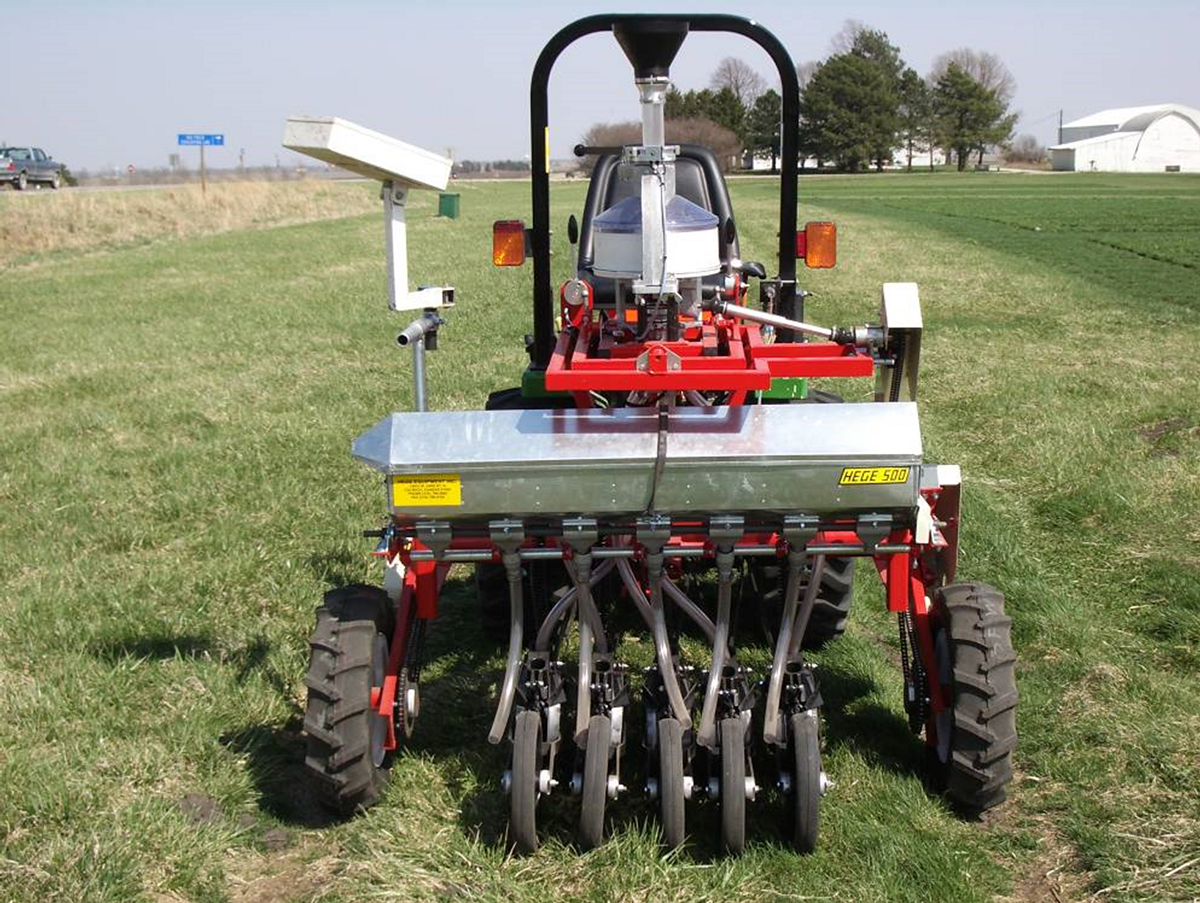
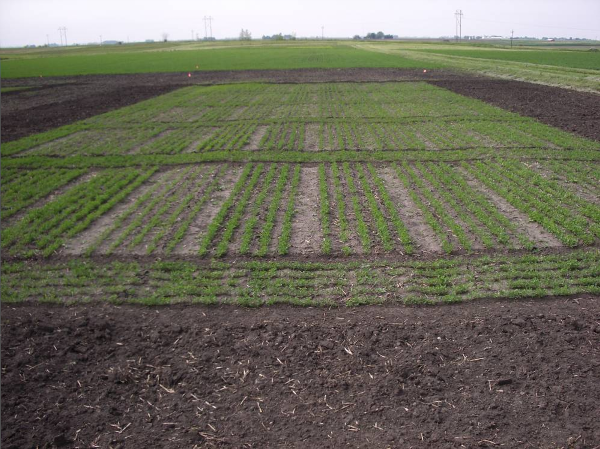

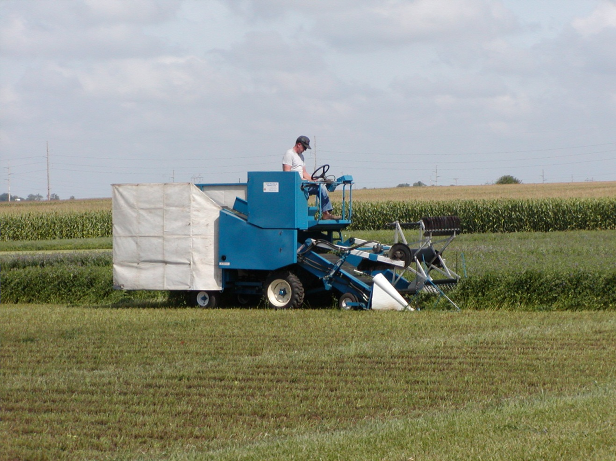
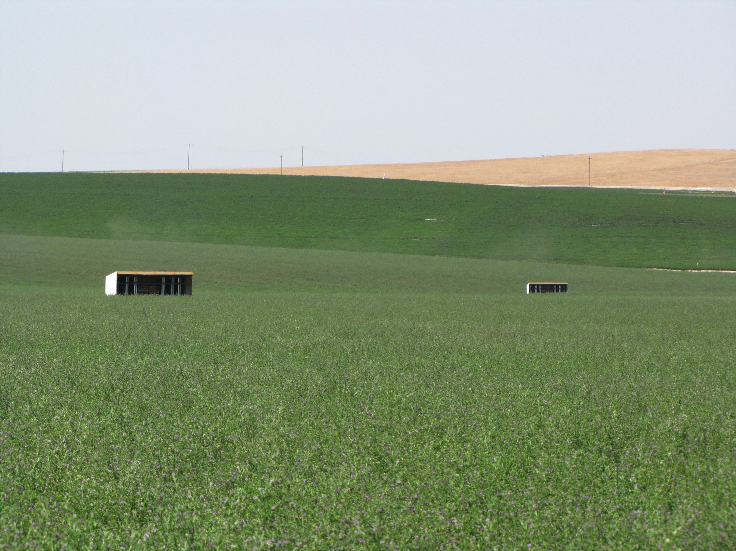
Step 3 – Evaluation of experimental synthetics
The two general types of synthetic cultivars are broad based and narrow based. Broad-based synthetics are based on a larger number of selected clones, while narrow-based synthetics are based on a relatively few selected clones. There is no specific number of clones that define the two types; however, broad-based synthetics generally would have between 20 to 100 parent clones and narrow-based synthetics generally would have less than 20 clones. Broad-based synthetics generally are based on parent clones that are selected only by phenotypic evaluation, while the clones for narrow-based synthetics are based on phenotypic and genotypic evaluation.
After clones are selected in step 2, they are used to make up experimental synthetics that have the potential to be a new cultivar. The experimental synthetics are designed to have the characteristics that are needed in the final cultivar. One experimental synthetic may emphasize the use of parent clones with resistance to certain diseases, while another experimental synthetic may emphasize resistance to other pests. A breeder may choose to use a parent clone in more than one experimental synthetic.
The parent clones per se are referred to as the Syn. 0 generation. The selected clones are planted in a polycross with vegetative propagules often are obtained from plants in the maintenance nursery. The options for design of the polycross, the number of replications, the method of harvesting, and the method of bulking the half-sib seed from the clones to form the Syn. 1 were previously discussed in Plant Breeding Methods.
When Syn. 2 seed is used to plant the test of experimental synthetics, the breeder plants the Syn. 1 seed in isolation, allows the plants to intermate naturally, and harvests the Syn. 2 seed in bulk. No attempt is made to harvest seed from Syn. 1 plants individually.
The breeder must decide whether to evaluate an experimental synthetic with Syn. 1 or Syn. 2 seed. The advantage of using the Syn. 1 is that it takes less seasons to produce the seed. The disadvantage of using the Syn. 1 is that it may not be a reliable indicator of the performance of the synthetic when it is sold commercially as Syn. 3 or Syn. 4 seed. The influence of linkage disequilibrium on the performance of a synthetic in the Syn. 1 versus later Syn. generations should be reviewed on pages 56–57 and 103–104 of the text and on pages 22–23 of the Chapter 11 on alfalfa breeding in Principles of Cultivar Development, Vol. 2.
Step 4 – Production of commercial seed
Based on the performance of the experimental synthetics, the breeder will choose one or more to release as a commercial cultivar. Vegetative propagules of the parent clones from the maintenance nursery will be used to plant a polycross to obtain Syn. 1 seed in the same manner discussed in step 3. The number of replications will be influenced by the amount of Syn. 1 seed that is needed for planting the size of a field that can produce enough Syn. 2 seed. In addition, it is common to produce enough Syn. 1 seed to put in storage for replanting a field for additional Syn. 2 seed, if necessary. Because the plants are perennial, it is possible to harvest Syn. 1 seed from the polycross more than one year.
The Syn. 1 seed is planted in the field with mechanical equipment. It generally is planted in rows so that it can be cultivated for weed control and for irrigation. The plants are cross-pollinated with each other. The Syn. 2 seed is harvested in bulk with a combine, similar to that used for other row crops. Syn. 2 seed can be harvested from the field for more than one year.
To obtain Syn. 3 seed, the Syn. 2 seed is planted and harvested in bulk as described in the previous paragraph. The Syn. 3 commonly is the class of seed sold for commercial plantings. If Syn. 4 seed is required, the Syn. 3 seed is planted and harvested in bulk as described in the previous paragraph.
The seed producer determines the Syn. generations that will be sold commercially, the class of certified seed used for each, and the number of times a field can be harvested for seed. The cultivar descriptions for alfalfa provided in the www site of the National Alfalfa Review Board are a valuable resource for understanding the alternative available for seed production of synthetic cultivars.
The reason for limiting the number of harvests from a field is to avoid a change in the genetic makeup of the plants in a field. The genetic makeup can change if some plants are lost because they cannot compete with other plants in the mixture. It also can change when seed from one harvest falls on the ground and germinates the following season.
Synthetics of maize
The development of synthetic cultivars of maize and other crops differs from that described for turfgrass and forage species because of several important biological differences.
- It is possible to inbred maize because inbreeding depression is much less than in turfgrass and forage species.
- There is no self-incompatibility in maize and some self-pollination can occur, even though it is a monoecious species that is wind pollinated.
- It is an annual crop.
Synthetic cultivars of maize can be developed by any of the methods of recurrent selection discussed in lessons 1 through 3. Commercial seed is produced by growing the cultivar in isolation each year. An example of the development of maize synthetics is the development of the maize population HIS1 that can be found at [JPR 3:10-13 (2009)]
Applied Learning Activity 11
Answer the following questions for the four synthetic cultivars listed below.
- ‘Recovery’ western wheatgrass – JPR 5: 367-373 (2011)
- ‘TifQuik’ bahiagrass – JPR 5: 147-150 (2011)
- ‘AU Red Ace’ red clover – JPR 5: 11-13 (2011)
- ‘Nelson’ annual ryegrass – JPR 5: 45-48 (2011)
- What were the parents of the population used for selection?
- How was the initial population formed for selection?
- Were phenotypic selection, genotypic selection, or both used to identify the clones used in forming the cultivar?
- Was recurrent selection practiced? If yes, describe what was done for one cycle of selection and indicate how many cycles of selection were performed?
- If genotypic selection was used, how many half-sib families were evaluated and how many years were they tested before the clones used in the cultivar were selected?
- How many clones were used to produce breeder seed of the cultivar?
- What Syn. generation was or will be sold to the farmer?
- What type of intellectual property protection has or will be sought for the cultivar?
Applied Learning Activity 12
The following questions pertain to synthetic cultivars of turfgrass and forage species.
- For an autotetraploid species, what are the possible genotypes that can occur when multiple alleles are present at a locus in a breeding population? Include the names commonly used in genetics to describe each of the genotypes.
- Assume that you have 95 elite clones available to you with which to initiate a breeding program for a crop species of your choice. How would you use the clones to develop a population in which to do selection without the use of artificial hand pollinations? Begin your answer with the clones growing in the maintenance nursery in the field and end when you have seed of the population in a bag ready to plant.
- You can develop either a broad-based or narrow-based synthetic. What is an advantage and disadvantage of each type?
- Outline one cycle of recurrent phenotypic selection beginning with the seed you developed in part 2 above and ending when you have seed of the cycle 1 population ready for planting. Indicate the number of plants you grow initially and the number of plants selected for crossing. Use an article for a synthetic cultivar in the Journal of Plant Registrations as a guide for your answer and give the reference citation for the article.
- Half-sib progeny testing also is used to develop synthetic cultivars. What are the advantages and disadvantages of half-sib testing compared with recurrent phenotypic selection for selection of superior clones? Describe how you would conduct half-sib progeny testing beginning with 60 clones that you selected from a population by phenotypic selection. Begin with the clones in the maintenance nursery and end when you have selected your clones.
- Assume that you have selected 34 clones to use in a commercial synthetic. Describe how you would produce Syn. 3 seed of the synthetic for commercial sale. Begin with the 34 clones growing in a maintenance nursery and end when you have the Syn. 3 seed ready to sell.
References
Anderson, W. F., R. N. Gates, W. W. Hanna. 2011. Registration of ‘TifQuick’ Bahiagrass. J. Plant Reg. 5:147-150.
Brewbaker, J.L. 2009. Registration of nine maize populations resistant to tropical diseases. J. Plant Reg. 3: 10-13.
Fehr, W. R. (ed). 1987. Principles of Cultivar Development. Vol 1. Theory and Technique. McGraw-Hill, Inc., New York.
Mosjidis, J. A. 2011. ‘AU Red Ace’, a Red Clover for the Lower South. J. Plant Reg. 5:11-13.
Nelson,L. R., J. Crowder, F. M. Rouquette, Jr. 2011. Registration of ‘Nelson’ Annual Ryegrass. J. Plant Reg. 5:45-48.
Waldron, B. L., K. B. Jensen, A. J. Palazzo, T. J. Cary, J. G. Robins, D. Peel, D. G. Ogle, L. St. John. 2011. ‘Recovery’, a New Western Wheatgrass Cultivar with Improved Seedling Establishment on Rangelands. J. Plant Reg. 5:367-373.

